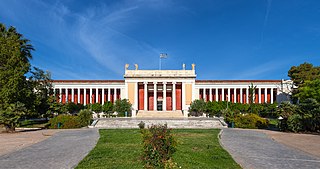
The National Archaeological Museum in Athens houses some of the most important artifacts from a variety of archaeological locations around Greece from prehistory to late antiquity. It is considered one of the greatest museums in the world and contains the richest collection of Greek Antiquity artifacts worldwide. It is situated in the Exarcheia area in central Athens between Epirus Street, Bouboulinas Street and Tositsas Street while its entrance is on the Patission Street adjacent to the historical building of the Athens Polytechnic university.
The Sounion Kouros is an early archaic Greek statue of a naked young man or kouros carved in marble from the island of Naxos around 600 BCE. It is one of the earliest examples that scholars have of the kouros-type which functioned as votive offerings to gods or demi-gods, and were dedicated to heroes. Found near the Temple of Poseidon at Cape Sounion, this kouros was found badly damaged and heavily weathered. It was restored to its original height of 3.05 meters (10.0 ft) returning it to its larger than life size. It is now held by the National Archaeological Museum of Athens.
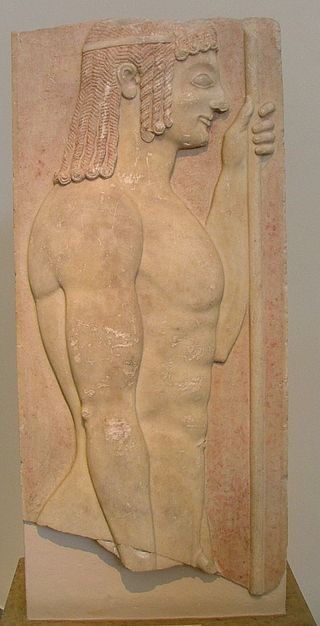
The Attic Grave stele in the National Archaeological Museum of Athens (NAMA) with the inventory number 7901 is an archaic grave marker of a young Greek, which was made in the middle of the sixth century BC.

An Attic funerary relief, sometimes also known as the Mithridates funerary relief is displayed at the National Archaeological Museum of Athens (NAMA), with the inventory number 4464. Its date is uncertain.

The Aphrodite of Syracuse is a statue of the Greek goddess Aphrodite in the National Archaeological Museum of Athens (NAMA) with the inventory number 3524 is dated to the second century AD.

The Stele of Aristion dates from around 510 BC. It was created by sculptor Aristokles out of Pentelic marble and shows traces of polychrome. It was found at Velanideza near Marathon in Attica.
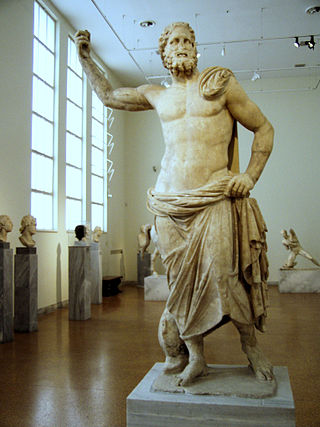
The Poseidon of Melos is a statue of Poseidon in the National Archaeological Museum, Athens (NAMA), with an inventory number 235, which is dated to the last quarter of the second century BC, thus to the Hellenistic Period.

The Statue of the priestess Aristonoe in the National Archaeological Museum Athens (NAMA), with the inventory number 232, dates from the third century BC.

The Varvakeion Athena is a Roman-era statue of Athena Parthenos now part of the collection of the National Archaeological Museum of Athens. It is generally considered to be the most faithful reproduction of the chryselephantine statue made by Phidias and his assistants, which once stood in the Parthenon. It is dated to 200–250 AD.

The Grave Stele of Dexileos is the stele of the tomb of an Athenian cavalryman named Dexileos who died in the Corinthian War against Sparta in 394 BC. The stele is attributed to "The Dexileos Sculptor". Its creation can be dated to 394 BC, based on the inscription on its bottom, which provides the dates of birth and death of Dexileos. The stele is made out of an expensive variety of Pentelic marble and is 1.86 metres tall. It includes a high relief sculpture depicting a battle scene with an inscription below it. The stele was discovered in 1863 in the family plot of Dexileos at the Dipylon cemetery in the Kerameikos cemetery of Athens. It was found in situ, but moved during World War II, and is now on display in the Kerameikos Museum in Athens.

The Grave Monument from Kallithea is a tomb of a family of metics from Histria, which was excavated in Kallithea. The monument itself dates back to around 320 BCE and contains a polychrome frieze. It is currently located at the Piraeus Archaeological Museum. This grave monument was built outside the Long Walls leading to Piraeus.

The Great Eleusinian Relief is a large marble relief kept in the National Archaeological Museum, Athens in Greece. It depicts a scene of the Eleusinian Mysteries with the principal deities, Demeter, Persephone and the hero Triptolemus. The large relief was unearthed in the town of Eleusis, which was an important center for the worship of Demeter and Persephone, in 1859.

The Atalante Hermes or Hermes of Atalante is a marble funerary statue of a youth depicted as Hermes, the god of messengers and psychopomp of the dead. It was excavated in the town of Atalante in Phthiotis, in Greece. It is now kept in the Archaeological Museum of Athens with accession number 240.
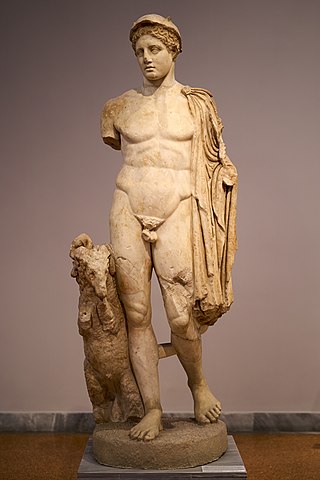
Hermes Criophorus is a marble sculpture of the second century AD depicting the Greek god Hermes, as god of pasture and shepherds, carrying away a young ram. The sculpture is a Roman copy of a Greek original of the fifth century BC. It was discovered in Troezenia in southern Greece in late nineteenth century, and it is now part of the collection of the National Archaeological Museum in Athens.

Hermes of Aegium is a lifesize Roman sculpture of the Greek messenger god Hermes found in the town of Aegium in southern Greece in mid nineteenth century. It is now housed in the National Archaeological Museum in the capital Athens under accession number 241. It is nearly intact with minor damage.

The Hermes of Andros is a large Roman marble sculpture of the Greek god Hermes, god of commerce and messengers, unearthed in the Aegean island of Andros, Greece. The sculpture was discovered in 1832, just two years following Greece's independence from the Ottoman Empire, and originally displayed in the National Archaeological Museum of Athens. Today it is housed in Andros, in the Archaeological Museum of Andros.

The Apollo Omphalos is an ancient Roman marble copy of a Greek original bronze sculpture in typical early Archaic period style, depicting Apollo, the Greek god of music, medicine, and prophecy. Today it is housed in the National Archaeological Museum of Athens, in Greece. The sculpture was found in several fragments which were put together, and bears several signs of damage.
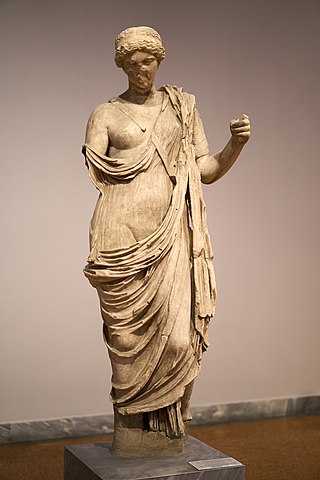
Armed Aphrodite is a first-century AD Roman marble sculpture depicting Aphrodite Areia, or the war-like aspect of the Greek goddess Aphrodite, who was more commonly worshipped as a goddess of beauty and love. It is modelled after a lost Greek original of the fourth century BC made by Polykleitos the Younger, and is now kept in the National Archaeological Museum of Athens in Greece with accession number 262.

The Group of Aphrodite, Pan and Eros is an ancient marble Greek sculpture of the first century BC depicting the goat-legged god Pan trying to woo Aphrodite, the goddess of love and desire, unsuccessfully. It was found on the Aegean island of Delos in the early twentieth century, and is now housed in the National Archaeological Museum of Athens with inventory number 3335.

The Funerary naiskos of Demetria and Pamphile is a tomb memorial in honour of two deceased women named Demetria and Pamphile, erected in Athens in around 320 BC, shortly after Pamphile's death. It is made of marble and now kept at the Kerameikos Archaeological Museum in Athens, Greece, with inventory number P687, while a copy of it is found on the ancient site of the tomb.




















